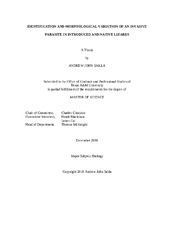| dc.description.abstract | Exotic species can threaten biodiversity by introducing parasites to native hosts.
Thus, it is critical to identify if the same parasite species is infecting both native and
exotic hosts. Developmental or environmentally induced variation in morphology,
however, may complicate identification. Geckos are one of the most successful invasive
families of vertebrates and are known to host lung parasites, pentastomids of the genus
Raillietiella. Raillietiellids have a cosmopolitan distribution, which in part, may have
been facilitated by the introductions of their hosts. Indeed, Raillietiella frenatus, a
Southeast Asian parasite, has been reported in Texas (TX) from the exotic
Mediterranean gecko, Hemidactylus turcicus. Here we report on the recent introduction
(between 1998 and 2008) of a Raillietiella sp. into an established population of H.
turcicus in Louisiana (LA). More critically, we found infections in native green anoles, a
new host record for pentastomes. Upon sequencing 604 bp of the pentastome’s
cytochrome c oxidase gene, we observed identical sequences from parasites of anoles
and geckos. In fact, there was no sequence variation between published sequences of R.
frenatus from geckos and cane toads in Australia. Interestingly, we found that traditional
taxonomic analyses based on hook dimensions would have led to the false conclusion of
two pentastome species within H. turcicus. But, as in Kelehear et al. (2011), when
pentastome body size is accounted for the distinction between the two groups disappears.
These results along with prior moulting studies on R. frenatus suggest hook size varies
ontogenetically. Nonetheless, even after accounting for pentastome body size, hook
dimensions differ significantly between host species. This result suggests these traits
may be plastic as a result of host environment, but quantitative genetic experiments will
be needed to disentangle phenotypic plasticity from genetic variation. | en |


